#nomadic camel soap
Explore tagged Tumblr posts
Text
Benefits of camel milk soap base
Camel Milk Soap is made by hand and uses the finest quality oils, along with pure and fresh camel milk. You can be assured that after using the camel milk soap for a few weeks, you will feel that your skin has become nourished, smoother, and wrinkle-free.

As you can see, camel milk soap is a product that deserves to be a part of your beauty routine. You must begin using Nomadic camel soap, as it is excellent for treating skin infections, dry skin, and gives you a luxurious bath experience too.
0 notes
Text
Trekking in Western Mongolia - Canoeing
Day 11
The next morning we began the water portion of the trip, setting off down river in the canoes and inflatables.
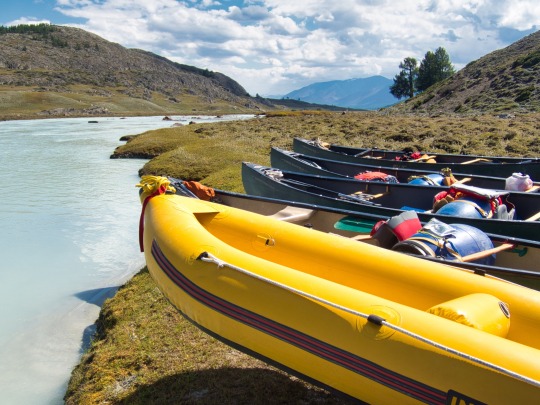
Instead of daypacks we were now using waterproof barrels in the canoes. We also needed river clothing and gear and not as much cold weather clothes or hiking boots. So another repacking and reorganizing was in order. It would all go in the vans, but we could declutter our bags and put a things we wouldn’t need for a while in separate bags.
We had to pass under a bridge that was low enough to require ducking very low. But first a railing on the bridge was broken and hanging down into the only span tall enough to get under at all. So a little remodeling of the bridge was required.
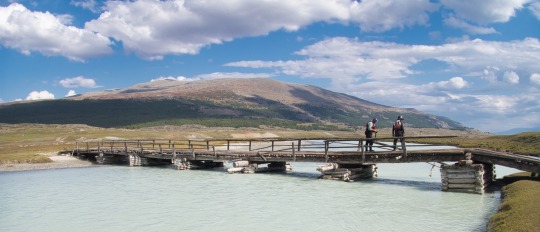
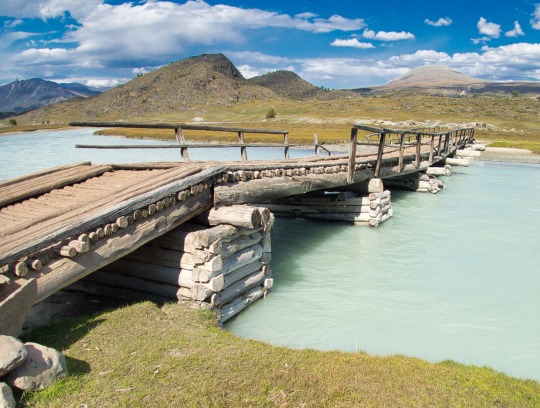
The river slowed and broadened as we neared Khoton Nuur, a 14 mile long lake. (Nuur = lake)
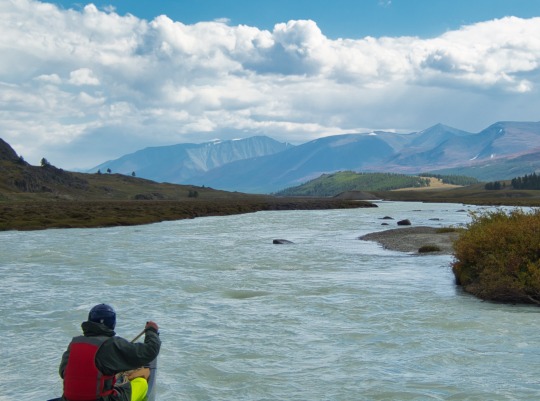
The photos get a little sparse at this point for a couple of reasons: the landscape is opening up, so the vistas are large, open and pretty flat, and I didn’t carry my camera with the big zoom in the canoes. I’ve water damaged cameras on river trips before, so I only took a waterproof camera when on the water. But that camera had very little zoom. So little zoom and wide spaces don’t make for many compelling photos. Most times in camp I could get to the big camera, but not always.
We camped just before the lake.
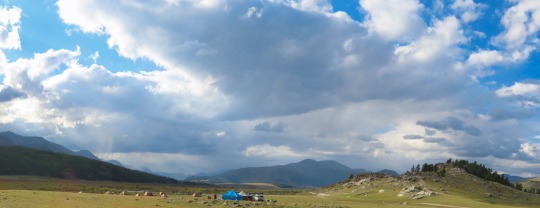
Day 12
We had a great view of the mountains behind us early in the morning.
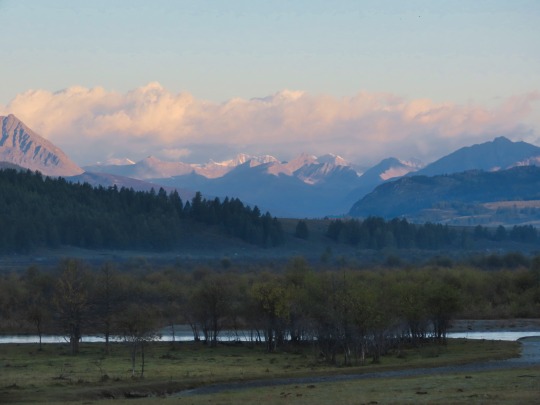
Then we headed out onto the lake. Canoeing on a lake means no current, so all this distance we made was by our own paddling and that wind can become a big issue. Headwinds or course would slow us down, but high winds make the whole enterprise much more risky. The winds are strongest in the afternoon, so we tried to get going in the morning to make as much progress as possible before the winds picked up.
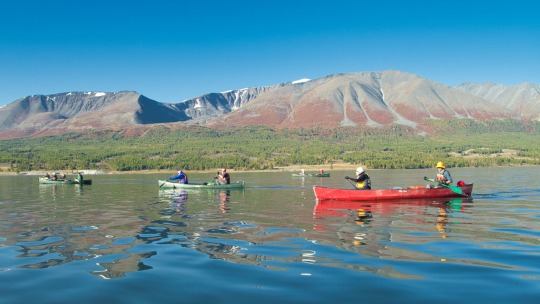
Offsetting that plan though was the practice of stopping to visit local families. When these stops occurred in the morning, it put us at risk of paddling in heavier winds in the afternoon.
We stopped pretty quickly to visit a family that Tim had visited before. We had to walk a long distance to get to the family’s gers and as we did we could see a truck driving off and no livestock. It turned out that the family was in the process of leaving for their fall location. The boys had left earlier driving the herd animals and the truck had left with the first load of the household goods. The family said that the boys had been looking for us as Tim had visited about this same time twice before and were disappointed to have to leave before we showed up. We left some gifts with the family for the small kids that were there as well as kids that weren’t.
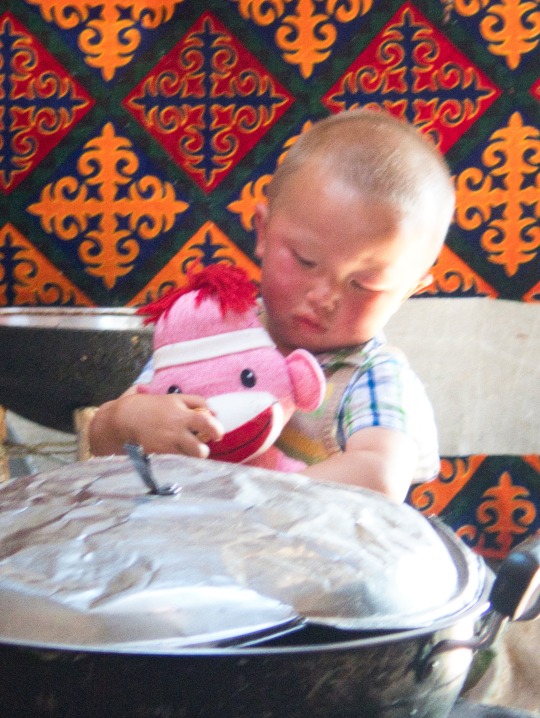
They gave several of our people gifts of dried curd. We really didn’t realize how much until that evening when everyone presented their dried curd to the cooks. It was quite a pile. None of us had any idea what to do with it. It is hard as a rock, so gnawing on it was not an option. I guess it is used to make a broth.
They explained that the reason they were leaving a little early was that bears from the mountains behind them were attacking their stock.
After we left the family we passed a gap in the mountains to the south and found ourselves in a strong cross wind. We had to change course to get close to shore and paddle pretty hard to get out of the strongest wind. The experience made me more aware of the gaps in the adjoining mountains and the potential for winds to blow through those gaps and out onto the lake. (When I’m paddling hard there’s little opportunity for photos!)
After we got past the wind we found a narrow spot without much wind and crossed over to the north side of the lake where our camp was set up.
We got a good view of the crescent moon between the clouds after sunset. Judy said it’s called “the new moon in the old moon’s hands,” which I hadn’t heard, but is a nice phrase.
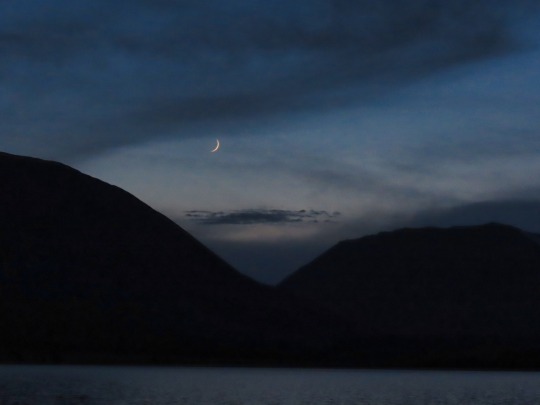
Day 13
This was a “rest” day, meaning we didn’t paddle. But most of us hiked up the adjoining hills or such. It was good weather early and I was up, as usual, so I did a walk up the hill behind camp for some nice dawn light shots.
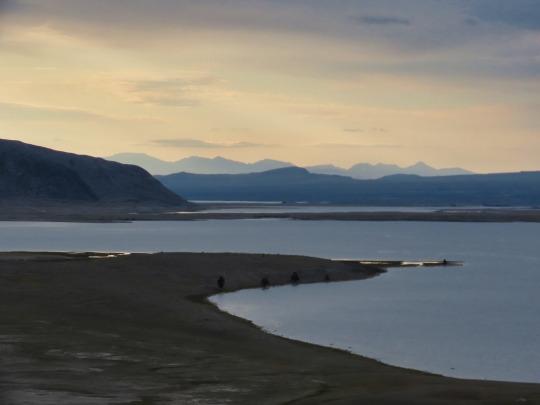
It turned out to be a good day for a rest day as it was the rainiest day so far and at times windy. So we were able to retreat to a tent in the worst weather and head out for short walks when it was looking better.
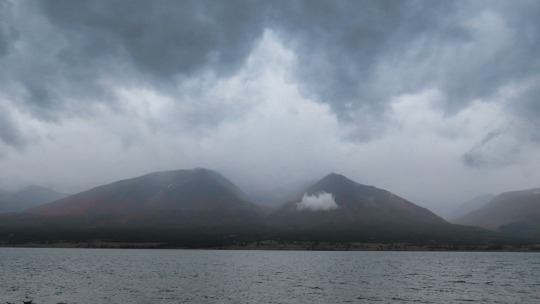
With the change from camel supported to vehicle supported weight was no longer such an issue and we found we had several additional items along: a collapsable stove for the dining tent, and a generator to support electric lights in the cook and dining tents and a charging station for the cameras, phones, GPS devices etc. The stove could burn wood, but usually, as with the nomads, manure. It did keep the dining tent warmer and helped to provide a place to dry wet gear at the end of the day. (Cold, damp neoprene socks in the morning are not appealing!)

We had been using extra batteries and power banks to keep electronics running, but that wasn’t going to last much longer for many items, so the ability to recharge was welcome.
We had some nice color in-between the clouds at sunset.
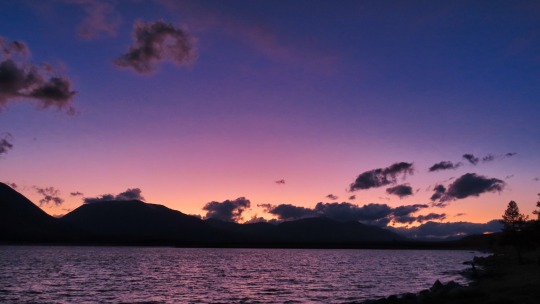
Day 14
Another re-packing as we were camping on an island tonight and so would have no support vehicles. So we packed more stuff into our waterproof barrels and added tents, food, and other gear into the canoes. That made them heavier and less stable, so we needed to be a little more careful paddling.
I hadn’t done this much paddling for many years and frankly I was pretty rusty. So I had to work to get a good stroke down. As we paddled I was remembering paddling with Cathie on trips to the Boundary Waters in northern Minnesota. We worked at paddling straight and paddling smoothly and silently. So I started working on that and got, Bhugii, my canoeing partner doing the same. I found it very efficient paddling and very enjoyable. I mentioned it as my favorite part of the day in the evening’s recap of the day.
We passed through a section of river and into a second lake, Khurgan Nuur, to get to our island camp. There was a store and a border guard station along the river. The store was the Mongolian version of the country store of days ago: an assortment of clothing items, package food items, sundries etc. Certainly nothing I needed, but it was the only store for many miles.
We also stopped to visit a family and the kids were fascinated by the canoes, so the guides took them out for a few minutes which delighted some and terrified others.
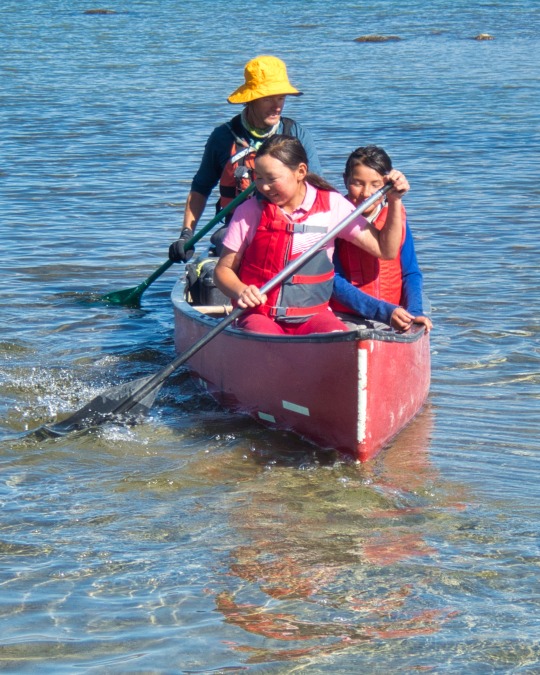
The island is uninhabited but has a herd of horses on it as there is good grass and they are pretty safe there.
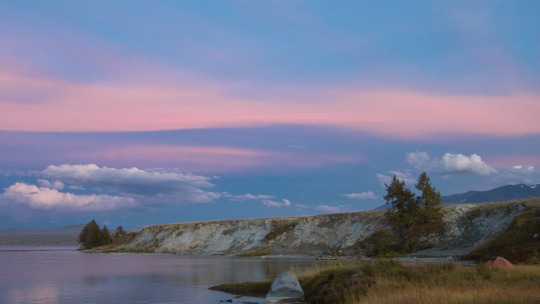

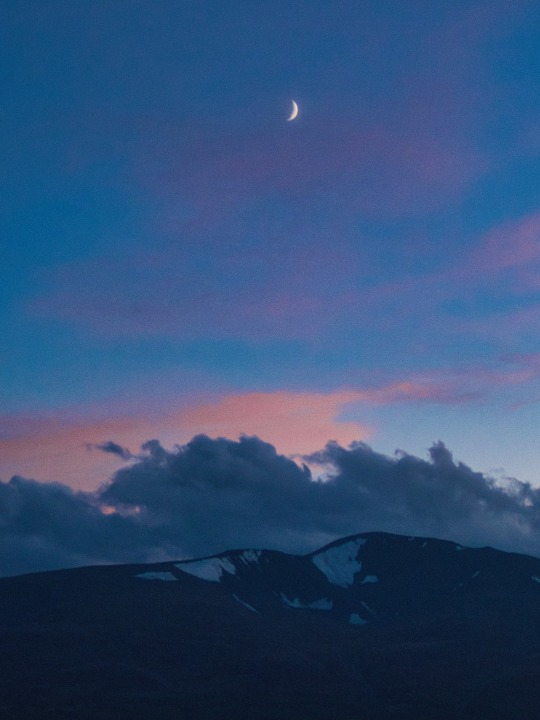
Day 15
We woke to scattered clouds in the east and a stunning sunrise.
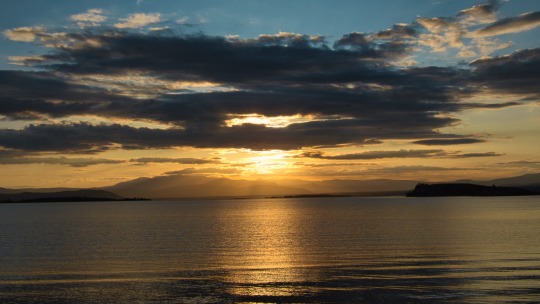
We set out early to get across the lake. As we were paddling we could see clouds and rain on the mountains behind us and could tell that it was moving our direction. So we paddled pretty persistently trying to keep ahead of it.
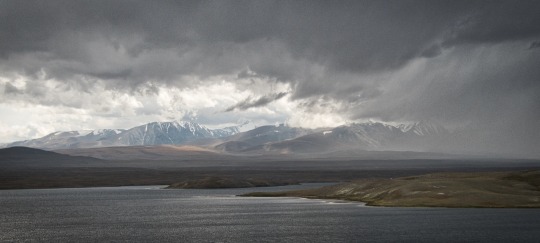
Of course that didn’t stop us from stopping to visit. This time the family wasn’t in a get, but a one room log cabin, but there were no animals. They explained that this was their spring residence. Their herds had been taken to their fall residence, but they were here to cut hay to store for spring.
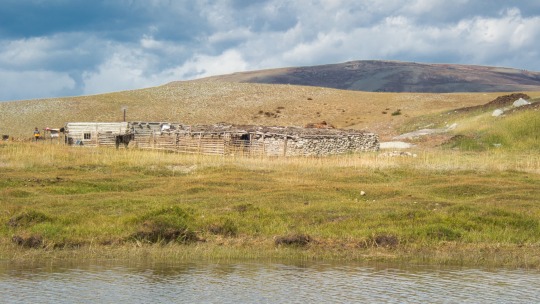
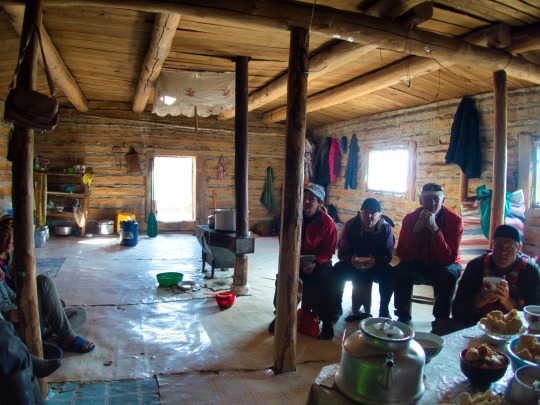
Their grass at their winter location will run out before the spring grass is up enough to fee their animals, so they cut grass in the fall at their spring home, so there will be supplemental hay available in the early spring. It clearly takes a lot of work and planning to be a nomad in this area.
Outside there was a large pot on a fire with something very dark and thick cooking in it. I suggest it looked like Jeff’s coffee, but in fact it was home-made soap.
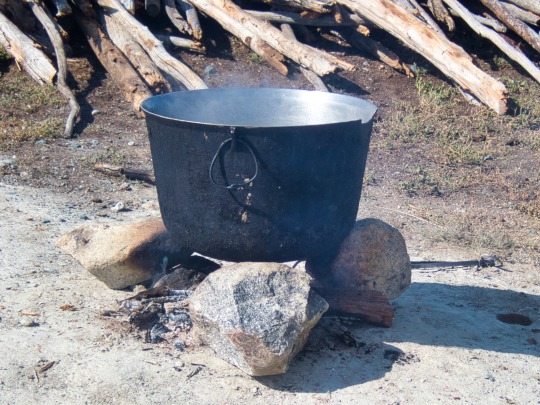
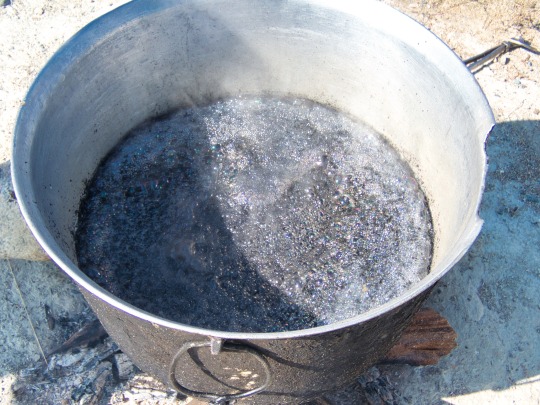
After leaving them we could see the rain coming closer and paddled pretty hard for the far shore where our vehicles and lunch were waiting for us. We landed and pulled the canoes out of the water just as a strong, cold wind hit. So it was excellent timing.
The rain was just sprinkles and after a quick lunch we walked a few kilometers to the evening camp on the river downstream from the lake. (This section of river was not suitable for canoes, although the two inflatables did paddle it.)
Our camp was immediately adjacent to a family’s get and animals. Like all nomad families they had a guard dog to protect against wolves. This dog worked overtime all night long, patrolling all through and around both our and the family’s camp, barking the entire time.
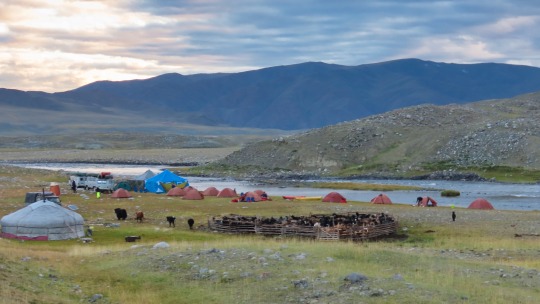
1 note
·
View note
Text
Jenna and Josh Densten’s Dreamy New Family Home
Jenna and Josh Densten’s Dreamy New Family Home
Homes
by Lucy Feagins, Editor

‘Traeger’ smoker by BBQs and Outdoor. Curtains from DIY Blinds. ‘La Paloma’ bricks in Miro from Brickworks. Photo – Eve Wilson for The Design Files. Styling – Annie Portelli.
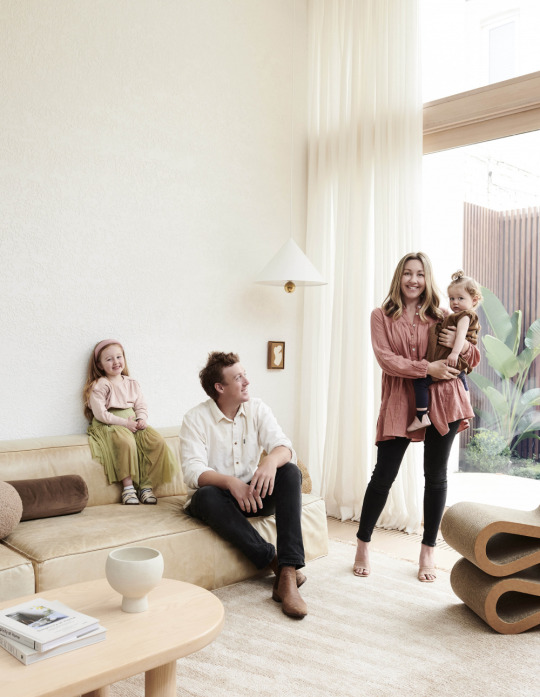
Family portrait, from left: Fred, Josh, Jenna and Story. Vase by Marloe Marloe. Ball cushion by The Creative Muster. Bolster cushion by Klay. Pendant light by Daniel Emma. Curtains from DIY Blinds. Vintage sofa sourced from En Gold. Coffee table by Softer Studio. Photo – Eve Wilson for The Design Files. Styling – Annie Portelli.

Heatmaster B750 fireplace. ‘La Paloma’ bricks in Miro from Brickworks. Woodcut colour Voss flooring. ‘Epic’ rug in camel from Hali Rugs. Coffee table by Softer Studio. Boucle ‘Joy’ armchair by Jardan. Wiggle Chair by Frank Gehry. Photo – Eve Wilson for The Design Files. Styling – Annie Portelli.
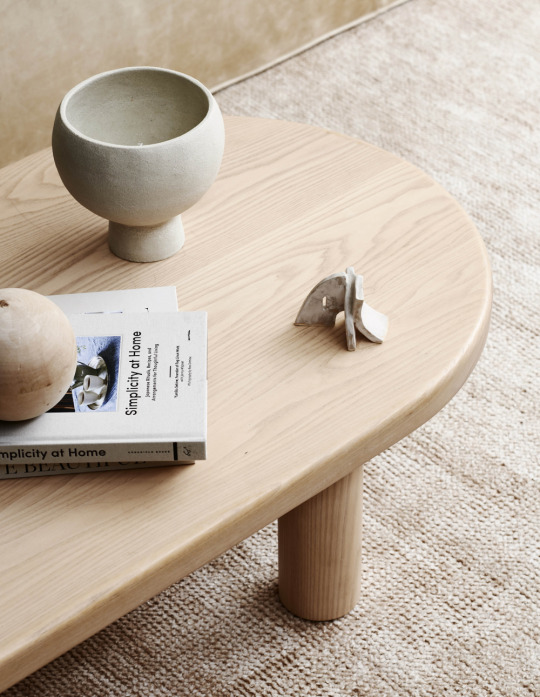
‘Epic’ rug in camel from Hali Rugs. Coffee table by Softer Studio. Vase by Marloe Marloe. Small object by Natalie Rosin. Photo – Eve Wilson for The Design Files. Styling – Annie Portelli.

‘Epic’ rug in camel from Hali Rugs. Coffee table by Softer Studio. Woodcut ‘Voss’ colour flooring. Boucle ‘Joy’ armchair by Jardan. Wiggle Chair by Frank Gehry. Pendant light by Daniel Emma. Curtains from DIY Blinds. Vintage sofa sourced from En Gold. Photo – Eve Wilson for The Design Files. Styling – Annie Portelli.
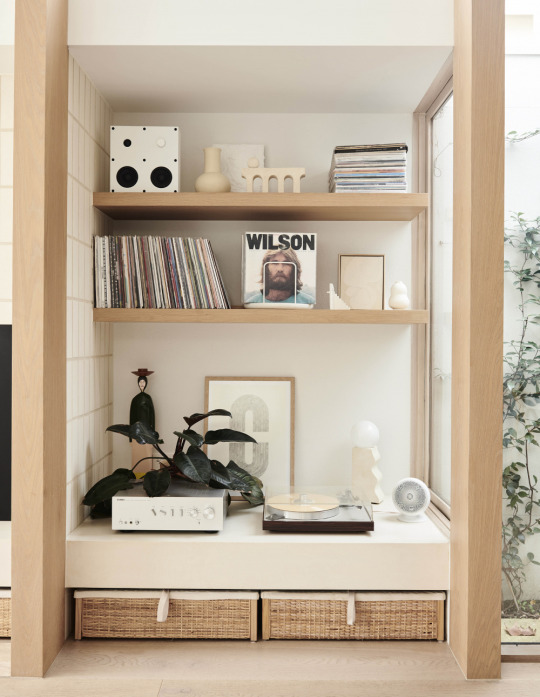
Lamp by Neighbourhood Studio. Lower artwork by Audrey Bodisco. Middle artwork by Clare Dubina. Upper artwork by Edit E. Woodcut ‘Voss’ colour flooring. Grey Earth Studio who did the concrete for the barbecue area and for either side of the fireplace. Photo – Eve Wilson for The Design Files. Styling – Annie Portelli.
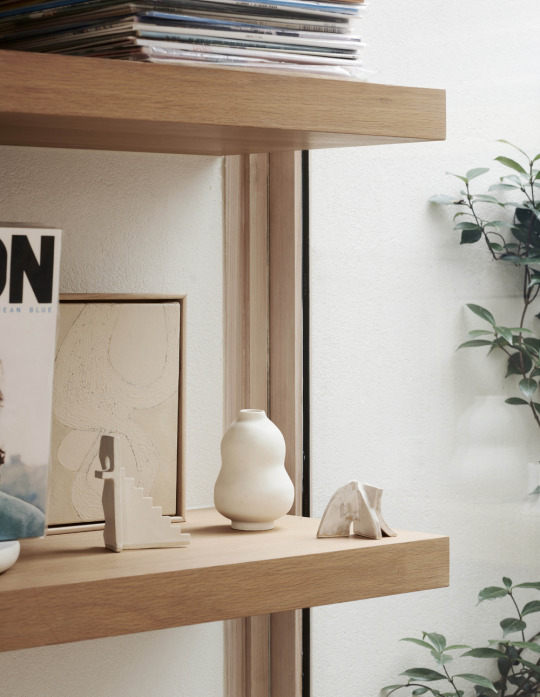
Artwork by Clare Dubina. Small object by Natalie Rosin. Photo – Eve Wilson for The Design Files. Styling – Annie Portelli.

‘Epic’ rug in camel from Hali Rugs. Coffee table by Softer Studio. Woodcut ‘Voss’ colour flooring. Boucle ‘Joy’ armchair by Jardan. Wiggle Chair by Frank Gehry. Pendant light by Daniel Emma. Curtains from DIY Blinds. Vintage sofa and dining chairs sourced from En Gold. Heatmaster B750 fireplace. Plant pots from The Pot Project. Custom designed dining table and mirror made by Joel Elliott furniture. Photo – Eve Wilson for The Design Files. Styling – Annie Portelli.

Storage baskets from Ikea. Woodcut ‘Voss’ colour flooring. ‘Epic’ rug in camel from Hali Rugs. ‘La Paloma’ bricks in Miro from Brickworks. Photo – Eve Wilson for The Design Files. Styling – Annie Portelli.
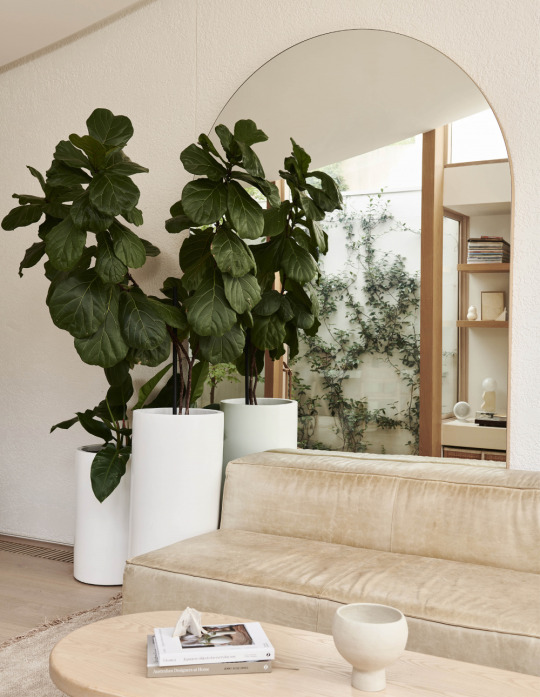
Vintage sofa sourced from En Gold. Plant pots from The Pot Project. Custom-designed mirror made by Joel Elliott furniture. Coffee table by Softer Studio. Photo – Eve Wilson for The Design Files. Styling – Annie Portelli.
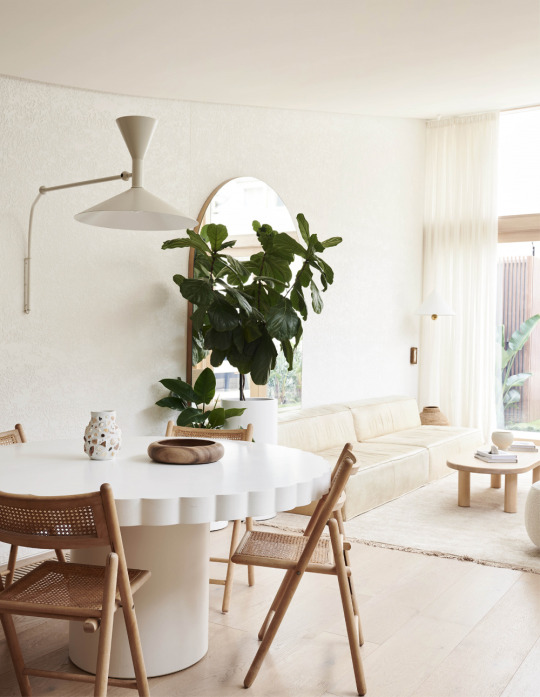
Lamp De Marseille wall lamp. Vintage dining chairs sourced from En Gold. Custom-designed dining table made by Joel Elliott furniture. Woodcut ‘Voss’ colour flooring. ‘Epic’ rug in camel from Hali Rugs. Vintage sofa sourced from En Gold. Coffee table by Softer Studio. Photo – Eve Wilson for The Design Files. Styling – Annie Portelli.
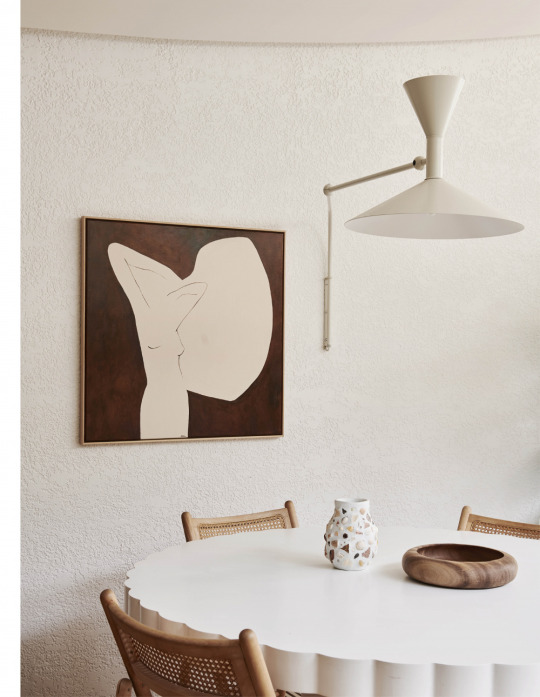
Lamp De Marseille wall lamp. Vintage dining chairs sourced from En Gold. Custom-designed dining table made by Joel Elliott furniture. Artwork by Clare Dubina. Memor vase from Tigmi Trading. Timber bowl from Mcmullin & Co. Photo – Eve Wilson for The Design Files. Styling – Annie Portelli.
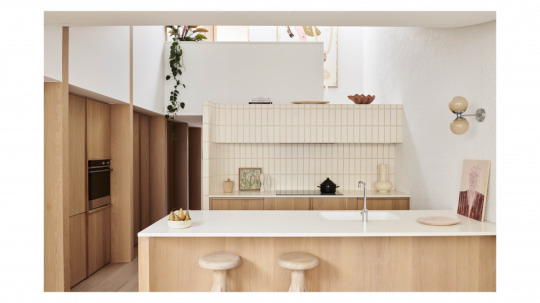
Tap by Brodware. Corian benchtop. Joinery by Joel Elliot Furniture. ‘La Paloma’ bricks in Miro from Brickworks. Left artwork by Carley Bourne. Right artwork by Stanislas Piechaczek. Back artwork by Ash Holmes. Wall light by Douglas and Bec. Vintage Artek Rocket Stool via Nord Modern. Photo – Eve Wilson for The Design Files. Styling – Annie Portelli.
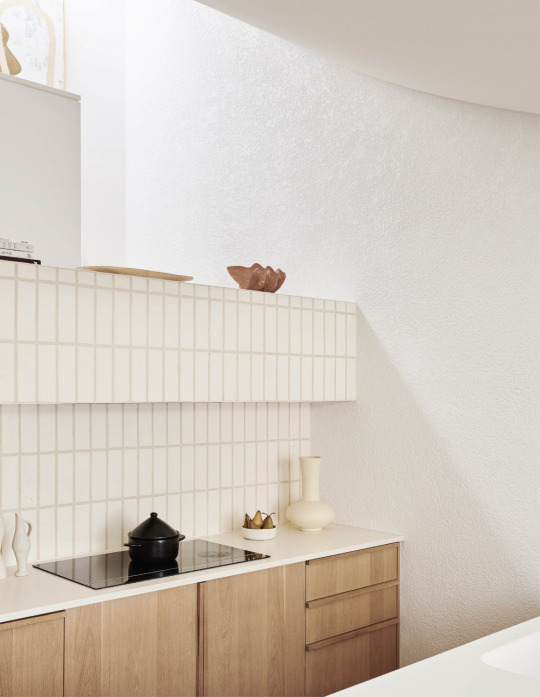
Ceramic objects by Ella Bendrups. ‘La Paloma’ bricks in Miro from Brickworks. Joinery by Joel Elliot Furniture. Photo – Eve Wilson for The Design Files. Styling – Annie Portelli.
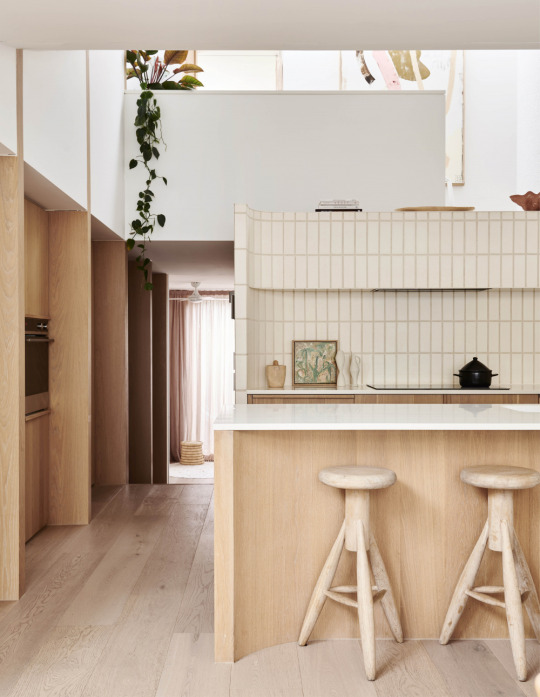
Tap by Brodware. Corian benchtop. Joinery by Joel Elliot Furniture. ‘La Paloma’ bricks in Miro from Brickworks. Left artwork by Carley Bourne. Right artwork by Stanislas Piechaczek. Back artwork by Ash Holmes. Wall light by Douglas and Bec. Vintage Artek Rocket Stool via Nord Modern. Woodcut ‘Voss’ colour flooring. Photo – Eve Wilson for The Design Files. Styling – Annie Portelli.

Woodcut ‘Voss’ colour flooring. Photo – Eve Wilson for The Design Files. Styling – Annie Portelli.
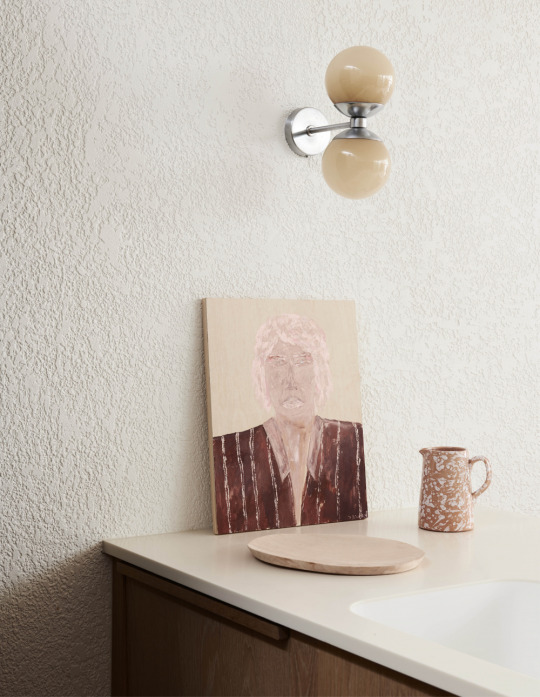
Right artwork by Stanislas Piechaczek. Pitcher from Tigmi Trading. Wall light by Douglas and Bec. Wetdash render wall finish. Photo – Eve Wilson for The Design Files. Styling – Annie Portelli.
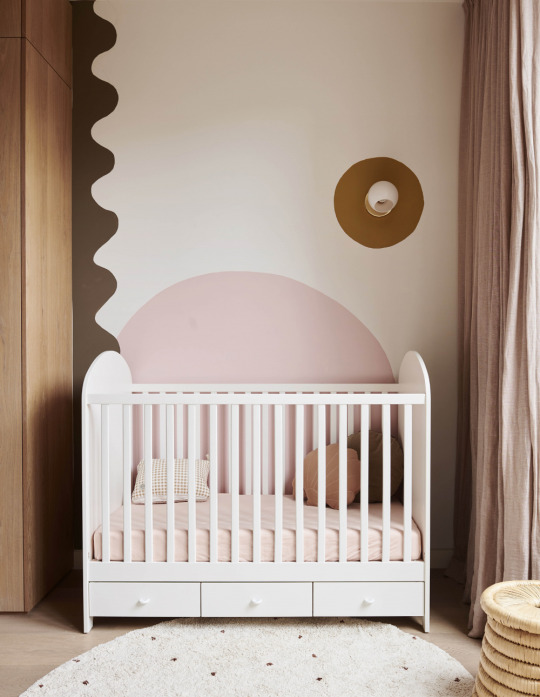
Curtains from DIY Blinds. Rug from Hunter & Nomad. Cot from Ikea. Stool from Pan After. Mural painted by Josh and Jenna. Photo – Eve Wilson for The Design Files. Styling – Annie Portelli.

Triple bunk custom designed and built by by Joel Elliot Furniture. Linen by Castle. Rug from Ikea. Wall sconces from West Elm. Curtains from DIY Blinds. Photo – Eve Wilson for The Design Files. Styling – Annie Portelli.
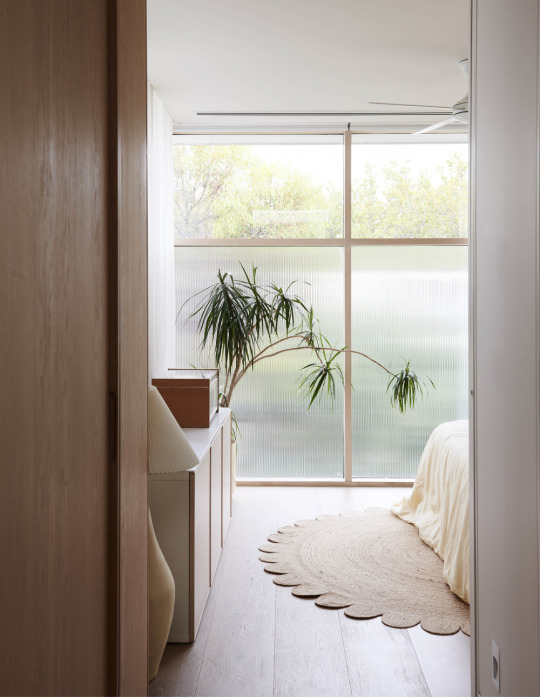
The view from the hallway into the main bedroom. Rug from Tigmi Trading. Photo – Eve Wilson for The Design Files. Styling – Annie Portelli.
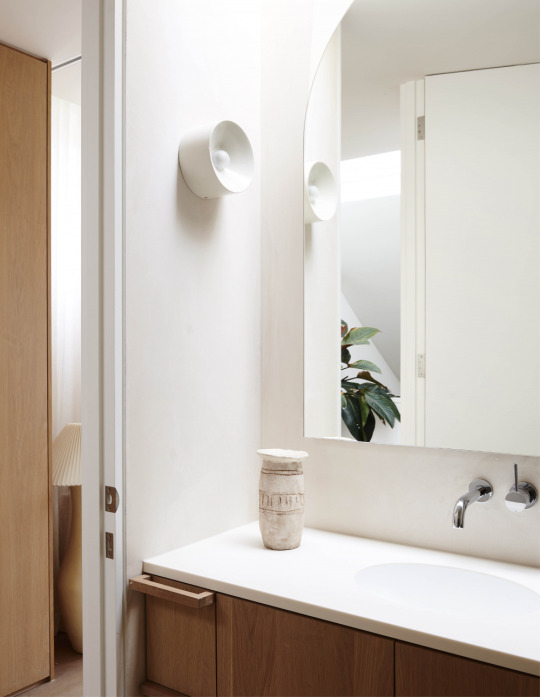
The main bathroom. Taps by Brodware. Wall light by Volker Haug. Venetian Plaster finish on walls. Photo – Eve Wilson for The Design Files. Styling – Annie Portelli.

Josh and Jenna’s room featuring seagrass wallpaper. Linen from The Sheet Society (‘butter’ colour). Art by Nastia Gladushchenko. Curtains from DIY Blinds. Vintage bedsides sourced from Curated Spaces. Bedhead from McMullin & Co. Photo – Eve Wilson for The Design Files. Styling – Annie Portelli.

The en suite. Tap by Brodware. Corian benchtop. Joinery by Joel Elliot Furniture. Soap holder by Dinosaur Designs. Tiles from Sarah Ellison Studio. Venetian Plaster finish on walls. Photo – Eve Wilson for The Design Files. Styling – Annie Portelli.

Linen from The Sheet Society in Butter. Art by Nastia Gladushchenko. Curtains from DIY Blinds. Photo – Eve Wilson for The Design Files. Styling – Annie Portelli.

The house completely opens to the central courtyard, flooding the living room with light. ‘Traeger’ smoker by BBQs and Outdoor. Curtains from DIY Blinds. ‘La Paloma’ bricks in Miro from Brickworks. Photo – Eve Wilson for The Design Files. Styling – Annie Portelli.
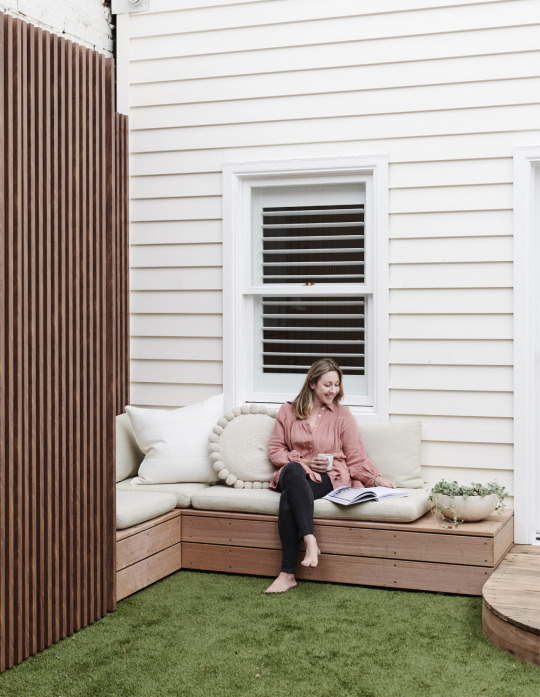
Timber-look screen that conceals a shed by Protector Aluminium. Photo – Eve Wilson for The Design Files. Styling – Annie Portelli.
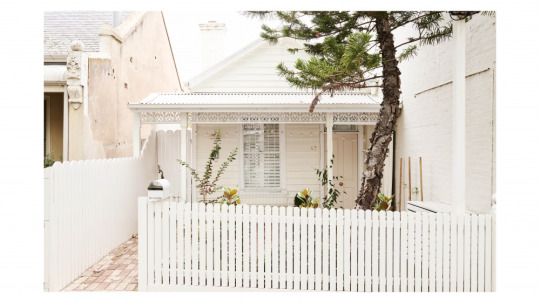
The quaint cottage facade neatly conceals the treasure that lies behind! Photo – Eve Wilson for The Design Files. Styling – Annie Portelli.
Josh and Jenna Densten give very good house. In fact, this dynamic couple (they really don’t need introducing but in case you’ve forgotten, Josh is a plumber by trade, whilst Jenna is an interior designer and founder of Design School) have renovated a total of 10 homes together, since the pair were just 18 years old. But this house, their brand new three bedroom home in North Melbourne, is one they plan on sticking with for a while. And we can certainly see why – it’s a total dream home!
In fact, this spectacular home is a lot more than meets the eye. Tucked inconspicuously behind the couple’s former home – a tiny single-fronted worker’s cottage on a narrow 5 metre wide site in North Melbourne – its scale and sweeping ceilings are totally unexpected. How do you hide a house this distinctive, behind an unassuming little weatherboard cottage? It feels like a magician’s trick!
The house is a completely new freestanding dwelling, separated from the original house by a courtyard. It was designed by Foomann Architects, with the main purpose of providing more space for Josh and Jenna’s young daughters, Fred and Story. The original weatherboard dwelling on the site, which sits at a mere 32 square metres, has since been converted into a self-contained guests’ quarters.
‘The rear dwelling was pulled toward the back of the block so it would become north-facing onto the courtyard,’ says Josh. ‘The home also has a small courtyard in the centre, and another at the rear, off the kid’s bedrooms, which has become a private, shaded play retreat.’ Not an inch of space on this inner city block is wasted!
Inside this new home, you’ll find the same calming interior aesthetic that Josh and Jenna have become known for. ‘We love soft lines, textures, timber, neutral colours, and creating a calming, cohesive atmosphere’ says Jenna – all of which is reflected in this serene, airy space.
‘We love how uncomplicated the home is. We love the combination of large windows, curves, internal courtyards and timber,’ Josh says. ‘It’s the perfect balance for us – straightforward design, but still enough space for us to showcase our collection of art, records and ceramics.’
Of particular importance to Jenna and Josh has been curating the home’s furniture and decor. ‘We had to be patient, and always on the lookout for the perfect ceramic or armchair. Lots of mood boarding!’ says Josh.
Personal touches such as Josh’s record player and vinyl collection instil a homey feeling, which is amplified at night when the children are in bed and the couple can listen around an open fire!
It’s been a labour of love, but now that the house is finally finished, Josh and Jenna have set their sights on a new (slightly more modest) project – renovating an old RV! They just can’t kick that renovating bug…
If you’re also a keen renovator, be sure to check out Jenna’s business, Design School, offering accredited interior decoration courses and online masterclasses, to learn how they do it!
0 notes
Text
History of Cheese
History of Cheese
The history of cheese. Exactly how did cheese get started? What’s the tradition there?
Overview
— Farm Updates — History of Cheese — Lemon Cheese Recipe
Farm Updates
I don’t have a lot to report today about the farm. A bit about hay, the creamery and a story about the goats and their antics.
Hay and Creamery
Scott laid the first row of blocks for the walls of the creamery. Yay!!! He is off getting more hay today. He will be back at it tomorrow and every day as long as the weather holds. We work long hours around here. They are shorter during the winter due to the amount of daylight. As the days get longer, we will get more and more done on any given day.
Why is he getting more hay? As I have talked about, our cows are 100% grassfed and raised on pasture. They get stored grass in the winter – that’s the hay. Cows need a lot of energy to stay warm when it is cold. They handle the cold very well. But they eat more – sometimes a lot more – when it is really cold. We came up short on the amount of hay we needed due to the excessive cold this winter. The are eating a lot more to keep warm.
That brings up another quick point that I want to make. We endeavor to have 2 years of hay stored for just this reason. You never know when you are going to run short. Perhaps this year we will get that hay storage back up to snuff. It was there a couple of years ago. Sometimes these things just slip when other priorities demand our attention. It’s a daily juggling act. I think we are passable jugglers at this point. Still need improvement though.
Goat Antics
We had yet another case of unauthorized breeding on the farm a little over 5 months ago. Here’s the story.
After manifest evidence of unauthorized breeding, Scott looked to his calendar of events for more information. He found the facts of the incident on his calendar. I didn’t even know it happened. It was a small blip and he corrected it immediately. Let me back up a little.
We essentially maintain two herds / flocks of animals. One we call the “the boys” and the other is referred to as “the girls” even though there are a couple of “the boys” in there right now. That’s our authorized breeding in progress. Unauthorized breeding happens when “the boys” meet “the girls” on their own schedule outside of our desired parameters. As I said, we had an incident a little over 5 months ago.
Every morning during milking season we bring up “the girls” usually just the bovine species. We only milk the cows, not the sheep or goats. However, sometimes the other animals come up just for kicks. According to Scott’s calendar/diary, on September 30thlast year when he was returning the cows to the pasture, he noticed that a couple of the girl goats had joined the boys. With goats you never know how they get through a fence. But believe me, if there is a way, a goat will find it.
Goat Kids
So, Scott got the goat girls back with the rest of “the girls” herd. The renegade girls were in there for no more than a half hour – maybe 45 minutes. It just doesn’t take long does it? Fast forward to about 2 weeks ago, Scott was checking the herd and putting out hay. He noticed several goat babies running around out there. Of course, this had to be a day just before freezing cold was to come again. There you have it. Only 30 to 45 minutes and 5 months later – goat kids. Scott came and got me and we began goat kid rescue operations. Get them to shelter.
Immediately I found a set of badger marked twins from one gray badger colored doe. But Scott had mentioned that on first arriving with the hay he had seen a tiny black kid trailing after one of the black does. We searched and we searched and we searched but we could not find this kid. Goat kids are exceptional with hiding and camouflage. Scott finally decided he must have been mistaken. We both had trouble accepting that because it is really hard to mistake one of those tiny newborns for the grown ones, even it if was one of the smaller does from last year. But after a couple of hours and looking in every nook and cranny we could find, we gave up the search.
The next morning Scott came and got me again. This time he was holding a tiny black goat kid. God only knows where that kid was hiding. We reunited him with his mom and he seemed pretty happy about that. He was larger than the twins. We believe he could have been a day or even two older. Also, a single birth as opposed to a twin makes for a bigger kid. We estimated the weights of the twins at 3.5 and 3 pounds. The single was a bit over 4 pounds.
Joy and Loss
The story has a bit of a sad ending. The black one was running around fine for two days and then we found him dead one morning. I don’t know what happened. Perhaps he was stressed from a night away from his mom and was immunocompromised. Maybe he got too cold that one night. We just don’t know. Goat kids are extremely vulnerable in their first week. On a happier note, the twins are doing spectacularly.
Those are the only two kids we will have this year, knock on wood. There is also a nagging thought in the back of my mind that in another week or so we could have a few more. I’m not sure that we separated the baby boys from the herd before the oldest buckling was sexually active. I’ll let you know if anything changes there.
While I’m on the topic of births, I’ll mention a couple of other things. Like I said, no more goat kids this year. We paused on breeding the goats this year because we are evaluating whether we want to switch from cashmere goats for fiber to meat goats. We are looking at kiko goats which are a meat breed. We are not growing more goats until we make a decision about pressing forward with our original fiber plan or deviating slightly to the meat plan.
Sheep and Cows
As far as the sheep go, the ewes were bred on schedule and are due to deliver sometime after March 20th. We will move them to the pasture outside my living room window as their time gets closer. They are strong in pasture birthing but keeping our eye on them is important. Taking excellent care of our animals is high on our list of priorities. We will supplement their hay just a little with mineral-fortified feed two weeks ahead of their expected delivery. Losses, heartbreak and experience have led us to that added step.
We expect our first calf on March 30th. The good Lord willing and the creek don’t rise, we will have 5 healthy calves this year with no veterinary bills.
Alright, switching topics.
The history of Cheese
I don’t know if you think about how things that we have and do today evolved over time. From time to time, I ponder it. Throughout my life I’ve had a penchant for history and tradition. Just how did we come to the place where we are today? How did “this” or “that” method or tradition come to be? Why is it always done that way now? Here’s a deep one. How did humans figure out that traditional committed pair-bonding between two individuals led to a stable family and continuation of the species? Who figured out why that worked? And what were the traditions passed down through generation after generation to ensure that it happened? What about soap making. It’s a chemist’s endeavor. What brain came up with the method?
Today I want to talk about the path of our ancestors that led to preserving milk and making cheese – also significantly contributing to the survival of the species. I’ll share and pass on some tales about how it MIGHT have happened. And a bit about where we are today as some traditions fall away and others evolve.
When did people first begin to make cheese? The most repeated story is that it was discovered by nomadic peoples. People who traveled by foot or beast of burden; horse, donkey or camel. The story goes that they found that the milk they transported in bags made of animal stomachs solidified during the long day of jostling along on the back of a horse or donkey. Young ruminant animal stomach is the key there. Calves, kids, lambs. And while that may be the most oft told story, it’s not the only way cheese may have evolved.
We know that it doesn’t take a camel trip to cause milk to curdle – The rennet in the stomach of the ruminant will do that for sure. But leaving a bowl of milk sitting outside any hut or tent for a couple of warm days will do the job. Separate the curds from the whey and voilà – cheese!
I’ll provide greater detail on that process going forward, but that’s the basics. Warm the milk, add rennet or let the natural aliveness of the milk do its thing on its own, drain the whey. Cheese!
The Monastic and Small-Town Cheese Traditions
Moving forward in time, the Greco-Roman era produced documentation of cheese making. Cheese was an important food for the people of Greece and Rome.
After the fall of the Western Roman Empire, the monasteries rose to prominence. They were responsible for the survival of education and culture after civilization deteriorated with the fall of Rome. The monasteries perpetuated and protected the documents. Additionally, early medicines were developed in rudimentary pharmacies. You saw important advances in art, music, and cooking.
The monks were generally the most educated in that period of history. They were the landowners and the country folk of the land were their responsibility. Monks tended to the spiritual needs of the people, as well as their health and the process of growing, preparing and storing food.
The monasteries became a prominent developer and keeper of cheese making tradition. It was during this time that regional and distinct types of cheeses first arose. Maintaining a thriving small industry using the milk produced on church-owned land was central to the survival of the community. Monasteries used local labor and ingredients.
Peasant farmers and herders also made cheese from the milk of their sheep, goats and cows to feed their families. Cheese was one answer to the question of what to eat in the season when no milk was available. Traditional methods were developed.
Isolated valleys existed throughout Europe and were home to local societies with traditions and foods that were unique to their small worlds. Many still exist and have influenced the wonderful variety of European cheese we know today. There are hundreds of these cheeses passed down from generation to generation that are still available today. Many still operate under a type of “patent”. The cheese must be made in a specific region with milk obtained from a specific breed of cow, and processed using specific methods to be labeled with a specific name. Camembert d’ Normandy and Parmesan are two examples.
Industrialization
In the late 19th and early 20th centuries as urban society grew and food for more and more people was needed, cheese making was gradually taken over by industrial concerns able to produce huge amounts of cheap cheese for distribution over larger and larger distances. Because industrial production was able to mass produce cheese for masses of people at lower cost, it almost wiped out the market for small producers and cheese makers.
Mass production led to centralized industry and regulatory bodies. Why? Because quality is often sacrificed for quantity. Large quantity operations open the door for unsanitary conditions and unsafe manufacturing processes in an effort to save time and money. More people are involved. More places where contamination can occur. The next logical step is enforced and costly regulation for sanitation and production standards. This made it less and less profitable for artisans to continue. Their small operations do not have the same sanitation and manufacturing issues though they are still required to pay the price.
One exception is France, which, because it started with a very large artisan community, was able to maintain a presence in the field. However, even now, the European Union is gradually instituting policies that are difficult for some farmstead producers to comply with, leading them to give up their craft. As we move forward with technology, hand-crafted products made with love and devotion and the accompanying tradition sometimes get left behind. The tradition becomes hidden away like a fine painting stored and nearly forgotten in a closet. As with most developments in society, there are positive and negative sides to industrialization.
Today there is a revival of people like us who are wondering if something valuable has been lost in the process. We are looking into the closet and retrieving the priceless art stored there. The desire for transparency in food production is becoming a public demand. The desire to know the composition of our food is probably the biggest reason we started on the path of making all of our own food. We wanted to know exactly what we were eating. Perhaps you do to.
And let’s talk about the environmental impact. Long-distance transportation carries a high cost to the environment. Our Farmer’s market and many more like it attract those who desire more and more to choose locally grown and artisan produced food over imported and industrial produced foods. A product lovingly crafted by hand costs more. But it’s not about money is it? It’s about the physical health of our families, the economic health of our communities, the humane treatment of living creatures and conservation of the planet we inhabit.
We are seeing growing interest in our craft. Every year sees an increase in artisan cheese consumption, though the number of small-scale cheese makers is still quite small. It ain’t easy being cheesy, but we want you to be able to experience the taste of fresh handmade cheese and discover the joy of creating a wonderful food made from a simple ingredient: fresh milk.
Cheese Trivia
Number one: the terms “big wheel” and “big cheese” originally referred to those who were wealthy enough to purchase a whole wheel of cheese.
Number two: Cheese was once used as a currency in medieval Europe. Cheese and other agricultural products were regularly used to pay church taxes. Some “tithe barns” (ancient buildings where the portion owed to the state, land owner or church was collected) still exist.
Today’s Recipe
The recipe for today’s podcast is: lemon cheese
Lemon cheese is a very simple fresh cheese that you can easily make in your kitchen. It is a moist spreadable cheese with a hint of lemon taste. If you make it in the evening, this rich and delicious cheese will be ready to spread on bagels or hot croissants for breakfast in the morning!
The ingredients are simple and the steps are few. Let me first provide a list of equipment you might want to gather.
Equipment
5-quart pot, stainless steel, glass or ceramic
Any food thermometer that measures 165 F.
Large spoon
Fine strainer or colander
Butter muslin (a clean old t-shirt will do in a pinch)
The ingredients are simple:
1 gallon of milk (do not use ultra-pasteurized, it will not set up)
2 large lemons or ¼ cup of lemon juice
salt
The steps are few:
Warm the milk (to 165 F). Stir often so as to not scorch the milk.
Add the lemon juice to the milk. Stir and set aside for 15 minutes.
NOTES: The warm milk will separate into a stringy curd and a greenish liquid whey. It should be clear, not milky. You can add more lemon juice if your milk did not “set” (coagulate).
Line a colander or fine strainer with the butter muslin. Pour the curds and whey into the colander.
Tie the four corners of the cheesecloth into a knot and hang the bag of curds to drain for an hour or so. Or until it reaches the desired consistency (think spreadable cream cheese).
Remove the cheese from the cloth and place it in a bowl. Add salt to taste, usually about ¼ teaspoon. You can also add herbs if you like. Fresh dill comes to mind.
Store in a covered container in the frig for up to a week.
That’s it! Enjoy! Recipe link is here.
SUMMARY
Hope you enjoyed the farm updates. Follow us on Facebook @peacefulheartfarm for some cute pictures of those goat kids.
Did you learn some new things about cheese? The traditional methods we use to make our artisan cheese evolved from those roots.
Let me know how that lemon cheese went for you. Feel free to ask me questions and provide feedback on your results. Leave us a comment on our Facebook page. Again, @peacefulheartfarm.
As always, I’m here to help you “taste the traditional touch.”
Thank you so much for listening and until next time, may God fill your life with grace and peace.
To share your thoughts:
Leave a comment on our Facebook Page
Share this show on Twitter, Facebook and Instagram
To help the show:
PLEASE LEAVE A REVIEW for Peaceful Heart FarmCast on iTunes.
Subscribe on iTunes, Stitcher Radio, Google Play Music, TuneIn or Spotify
Donate on Patreon
Website
www.peacefulheartfarm.com
Patreon
www.patreon.com/peacefulheartfarm
Facebook
www.facebook.com/peacefulheartfarm
NEW!! Peaceful Heart FarmCast Episode. Enjoy!!
0 notes
Text
Demand for chocolates, soaps, skin creams made from camel milk is growing
Demand for chocolates, soaps, skin creams made from camel milk is growing
On the edge of the Indian desert, Lakshman Raika boils tea with fresh milk from one of his camels, gently stirring the brew his tribal herdsman have consumed for generations.
Far away in city supermarkets demand for chocolates, soaps and skin creams made from such milk is growing — a boon for nomads like Raika and India’s fast disappearing camels.
Once dubbed the “ships of the desert” and…
View On WordPress
0 notes
Text
Camel Milk: Why Do You Need This In Your Home?
You always want to do the best for your family. And that starts from choosing the best foods for them. You ensure that they get as many nutrients as possible in their meals and that is why you select what foods to buy with care every time you go to the market. If you have always been buying cow milk to serve your family, perhaps you should consider trying camel milk. The advantages of camel milk are too many to be ignored. With availability online, supply is no issue as well. Here’s all you need to know about this wonder milk.

Many cultures consume it regularly.
The nomads and the Bedouins of Africa consumed camel’s milk regularly because they were the ones who owned and worked with this animal. In India, it is the state of Rajasthan that sees a lot of folks consuming this milk because of easy availability. So if you were to choose this wonder milk, it is not that you would be the first person to do so! People have been drinking it in plenty for centuries.
Help for parents of autistic children
What this milk does is it promotes better behavioural tendencies among autistic children. Numerous studies point out to this tendency which has been reported all over the world. It helps autistic children communicate and deal with the world more effectively and even causes an ease in the symptoms.
Good for increasing bone density
Strong bones form the basis of a healthy body. For children, the development of strong bones is a part of their growth. As people grow older, the importance of having strong bones increases. The weaker the bones, the higher the risks of contracting bone diseases including osteoporosis.
Great for the skin and the hair
When you buy camel milk powder for the family, expect everyone’s skin and hair to get better. So if you have a teenager daughter sulking about the pimples and breakouts on her skin, then this is a product she is going to love.
Prevention and treatment of diabetes
Diabetes is a problem in India because of the high consumption of fatty foods and sweets in India. It is a lifestyle disease and a sedentary person has a higher chance of getting afflicted by it. The good news is that camel’s milk is great for the prevention as well as the treatment of this condition. Whether it is in your tea or coffee, drink it multiple times a day for the maximum efficacy over the condition.
Great for pregnant women
Pregnancy is a time when most women are very careful about what they eat. They need to eat foods that are rich in nutrients. Camel milk products are a great choice for them. It enriches the health of the mother-to-be as well as her baby.
You get to choose from many camel’s milk products other than the powdered form which has to be mixed with water. There’s chocolate as well as soap made with this milk and they contain the benefits of this highly nutritious product.
0 notes
Text
New Post has been published on Dairy News India
New Post has been published on http://dairynews.in/indias-largest-dairy-brand-prepares-market-acquired-taste-camel-milk/? utm_source=Tumblr
India's Largest Dairy Brand Prepares To Market An Acquired Taste: Camel Milk
India’s Largest Dairy Brand Prepares To Market An Acquired Taste: Camel Milk
It’s nighttime in a forest in the western Indian state of Gujarat. By the light of his cell phone, camel herder Jat Saleh Amir, 18, pumps milk from the teats of groaning camels. The milk smells strong, like gamey butter.
Later, I join his family around a fire by grass reed huts. Everyone watches as I take my first sip of frothy camel milk from a steel bowl. I gag a little and smile apologetically – the milk is fatty, sour and salty. It’s nothing like any milk I’ve had before. “Tell them I like it!” I elbow my local interpreter Liyakat Ali Notiyar. When nobody’s looking, I slide Notiyar the warm bowl. Having grown up on camel milk, he slurps it clean in an instant.
(adsbygoogle = window.adsbygoogle || []).push();
Few Indians outside this district of Kutch and its community of camel herders drink camel milk. But that’s about to change as one of India’s largest dairy brands is set to mass market it. The milk will be sourced from this community of nomadic camel herders called Maldharis who roam the district of Kutch.
Maldharis have herded camels and consumed the animal’s milk for centuries. They drink camel milk tea and serve it plain with breakfast, lunch and dinner. And they consider the milk a cure-all – they tell stories about camel milk curing everything from acid reflux to fever and pregnancy ailments. They also believe it can help manage diabetes.
Elisha Harissa, 45, who has diabetes and lives in a nearby village regularly drinks camel milk. He claims it regulates his blood sugar. A few studies suggest there may be some scientific merit to these claims – camel milk seems to help regulate insulin secretion and blood sugar levels in patients with Type 1 diabetes – suggesting it could potentially be used alongside other medical treatments to manage diabetes. However, scientists are still investigating the therapeutic potential of camel milk.
Meanwhile, Amul plans to market camel milk primarily to people with Type 1 diabetes. And the company’s managing director, R.S. Sodhi, is confident the product will succeed, especially given the growing number of diabetics in the country. But he acknowledges there will be challenges. The main reason: the taste. Indians may not take to the unusual taste of camel milk. Even Kutch natives used to camel milk, like Asmok Ghor, whose grandparents transported goods back and forth to Pakistan on camels, can only stomach the sour milk if it’s boiled with sugar or concealed as ice cream. “I’m sorry,” Ghor says. “It’s not about the camels, I don’t like the milk.“
Sahjeevan is working with the local Kutch Camel Breeder’s Association to market creative camel products, including camel milk soap and camel milk chocolate. A few years ago, they even brought a European expert to teach herders how to make camel milk cheese. Amed Taju says the chocolate was a hit among the herders, but the cheese didn’t take off.
The success of Amul’s efforts with camel milk may help determine the future of Maldharis. Government-imposed restrictions on grazing land in recent years, a decline in the camel-for-transport market and the mining industries’ encroachment on grazing land have led to a decline in the number of camels owned by these communities. Amed Taju, a community elder, has had to sell many of his camels to get by. Now, his herd is half the size it was five years ago. Life is hard these days, says Taju. His children aren’t in school and he can’t afford health care. “We are poor people,” he says. “We are earning and eating, not saving.”
This is where Amul can help, says Sodhi. Amul will purchase the milk for at least twice its current value, encouraging Maldharis to increase their herds. It won’t be huge business for Amul, Sodhi says. “But for camel herders it will be big.”
If he’s able to sell camel milk routinely to Amul, Taju says he will build solid homes and send his grandchildren to boarding schools. “I see a future not for my sons and daughters,” he says. “But for my grandson and granddaughters.”
(adsbygoogle = window.adsbygoogle || []).push(); var VUUKLE_EMOTE_SIZE = "30px"; VUUKLE_EMOTE_IFRAME = "120px" var EMOTE_TEXT = ["HAPPY","INDIFFERENT","AMUSED","EXCITED","ANGRY"]
0 notes
Text
Demand for chocolates, soaps and skin creams made from camel milk is growing
Demand for chocolates, soaps and skin creams made from camel milk is growing
On the edge of the Indian desert, Lakshman Raika boils tea with fresh milk from one of his camels, gently stirring the brew his tribal herdsman have consumed for generations.
Far away in city supermarkets demand for chocolates, soaps and skin creams made from such milk is growing — a boon for nomads like Raika and India’s fast disappearing camels.
Once dubbed the “ships of the desert” and…
View On WordPress
0 notes